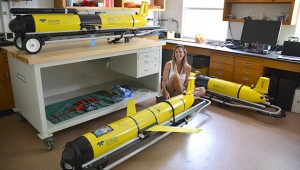About the Mid-Atlantic Glider Initiative and Collaboration
The Mid-Atlantic Glider Initiative and Collaboration (MAGIC) was launched at BIOS in 2014 to enhance and leverage BIOS’s long-standing ocean measurement programs southeast of Bermuda through the use of autonomous underwater vehicles. The overarching goal of MAGIC is to acquire new high-resolution measurements from underwater gliders to assess the contribution of small-scale processes that sustain the ocean’s biological productivity, and to make those assessments over several years to build a statistically meaningful understanding of them.
Glider Fleet
The BIOS AUV fleet is comprised of three Slocum G2 gliders from Teledyne Webb Research, each with a buoyancy engine that enables the gliders to dive to 1000 meters depth. For an introduction on how gliders work, watch the video below.
The establishment of MAGIC was made possible by the generous support of the Grayce B. Kerr Fund of Easton, Maryland. Two of BIOS’s gliders are named for young siblings in the Kerr Family—“Anna” and “Jack.” Funding for BIOS’s third glider, “Minnie,” was generously provided by Simons Foundation International. The Simons Foundation selected the name to honor Marilyn Simons’s great-grandmother, whose nickname was Minnie.
Each glider is equipped with a variety of sensors: a CTD (for conductivity, temperature, and depth) and optical sensors that measure oxygen, fluorescence and backscatter, an indicator of the abundance of microscopic marine organisms in the water. Additionally, Jack has been outfitted with an Acoustic Doppler Current Profiler, or ADCP, which provides detailed profiles of ocean currents; and Minnie is equipped with a state-of-the-art nitrate sensor to measure nutrients.
Watch the following video to learn more about gliders.


